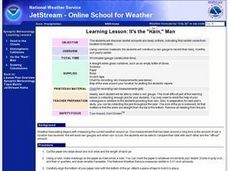Virginia Department of Education
Macromolecules
Finally, a chance for the class to play with their food! Allow pupils to simulate stomach acid with common foods, and introduce specific macromolecules into the mixture to explore characteristics of carbohydrates, lipids,...
Royal Society of Chemistry
Some Reactions of Carbon Dioxide—Microscale Chemistry
Precipitation reactions are always interesting. How about one that forms a precipitate using a gas? Chemists of any age will enjoy this twist on a standard solubility lab. Partners observe the lack of interaction between sodium...
Nuffield Foundation
Assessing Human Hearing
Young scientists explore hearing through multiple experiments, demonstrations, and activities. They focus on the changes in hearing over a lifetime, how we can determine where a sound is coming from, and the ability to filter noises.
Skyscraper Museum
What is a Skyscraper?
Skyscrapers are amazing feats of architectural design that create the iconic skylines of the world's biggest cities. Young architects explore the defining characteristics of these monstrous towers with the first lesson in this four-part...
Super Teacher Worksheets
Our Solar System Scavenger Hunt Activity
Send students on a search for facts about the solar system with this scavenger hunt activity. Whether they are finding out how far the sun is from the earth, or the names of all four gas giants, this resource will engage young...
PBS
The Little Red Hen: A Tale of Cooperation
Ensure that your kids don't even consider saying "Not me!" when it comes time to read by engaging them in this set of lesson plans based around "The Little Red Hen." The class reads the story together before starting in on additional...
Capo Beach Calvary
The Messiah Is Born
Use this simple nativity lesson in pre-kindergarten through third grade to familiarize children with Bible verses by way of a hands-on learning activity and coloring page.
Healthy Native Youth
Chapter 7: Revisiting the Circle of Life
Scholars revisit the Circle of Life to examine positive character traits—mental, physical, spiritual, and emotional. Pupils discuss how those character traits could help them make responsible decisions and not contract HIV/AIDS. Learners...
Curated OER
Learning Lesson: How To Make A Rain Gauge
Students discover that rainfall amounts are rarely uniform which means the amount of rain is different from location to location. They construct their own rain gauge using everyday materials.
Curated OER
Magnetic Car
In this magnetic car worksheet, students learn how to use simple household items to create a magnetic car. Students learn that magnets have two poles and when the same poles face each other it causes a force of repulsion which moves the...
Curated OER
Dinosaurs---Read All About Them!
Students read all about dinosaurs. In this biology lesson plan, students examine how to use library research as integral part of scientific research.
Curated OER
It's All In How You Look At It
Students work collaboratively to create artistic renderings of digital photographs using a color value scale and grid techniques in this late-elementary school lesson based upon Ted Rose's book Discovering Drawing. The lesson includes a...
Curated OER
Introduction to Bacteria
Beginning biologists survey several websites to learn about the types, structure, motility, feeding habits, and reproductive methods of bacteria. All websites are linked to the lesson plan, so you can have individuals access it and click...
Curated OER
Using Manipulatives to Teach Fractions
There is no doubt that learners remember what they have learned when they have a visual representation. Using an egg carton and candy bars, they explore the concept of fractional amounts. By having students cut the egg carton into parts...
Curated OER
Introduction to the Bill of Rights
Pupils evaluate what freedom means, how rules are important and the significance of individual rights. They find images that depict their interpretation of freedom and complete handouts.
Curated OER
Standard English
Double negatives are a no-no in the English language, yet you hear people using them all the time. "I ain't got no pencils," is a classic example. This presentation addresses double negatives, and teaches learners how to avoid this...
Education.com
Measure School Supplies
Ever wonder how long a pair of scissors are? Find out with this simple measuring activity in which pupils use the provided ruler to determine the length of four common classroom supplies.
Curated OER
How to: Build a Plant Cell
Students build a 3-dimensional model of a plant cell with household objects. In this plant biology lesson, students construct replica plant cells in groups of three. After completing their projects, students share their creations with...
PHET
Planet Designer: Retro Planet Red
What does the atmosphere on Mars look like? This fourth lesson in the series of five is designed for high schoolers. Scholars apply previous knowledge to add atmosphere to Mars in an online simulation. This comprehensive lesson includes...
Curated OER
Following Directions Using Magic Tricks
Students recreate magic tricks in an effort to follow directions. They evaluate the clarity of their instructions and teach an apprentice how to perform a trick. They are evaluated using a rubric to note the clarity of their directions...
Curated OER
Squares to Compare
Students investigate how to draw and classify two and three dimensional figures (squares, triangles, rectangles.)
Curated OER
S is for Scissors: The Letter S
In this letter S worksheet, learners can use a computer mouse to follow guided arrows showing how to form the letter, then practice printing the upper and lower case letter.
Curated OER
Watsons Go To Birmingham--1963Patricia Wachholz
Students research the 1960s to prepare for reading the book, The Watsons Go To Birmingham, by Christopher Paul Curtis. They watch a documentary, create a timeline, and listen to music from the 1960s.
Curated OER
Teaching Nutrition Using the Food Guide Pyramid
Second graders explore how to make healthy eating choices. There are goals included for students to meet by the end of fifth grade.

























